Identification and Deformation Characteristics of Active Landslides at Large Hydropower Stations at the Early Impoundment Stage: A Case Study of the Lianghekou Reservoir Area in Sichuan Province, Southwest China
Abstract
:1. Introduction
2. Study Area
3. Data and Methodology
3.1. Data
3.2. Methods
3.2.1. Identification of Active Landslides
3.2.2. Temporal Analysis of Deformation in Active Landslides
3.2.3. Pearson Correlation Analysis
4. Results
4.1. Active Landslide Identification Results
4.2. Deformation Characteristics of Typical Active Landslides
4.2.1. Boluzi Landslide
4.2.2. Waduo Landslide
4.3. Landslide Deformation Correlation with Reservoir Water Level and Rainfall
5. Discussion
5.1. Effect of the SAR Geometry
5.2. Response of Landslide Deformation to Reservoir Water Level
5.3. Response of Landslide Deformation to Rainfall
5.4. Limitations and Prospect
6. Conclusions
Author Contributions
Funding
Data Availability Statement
Acknowledgments
Conflicts of Interest
References
- Tang, H.; Wasowski, J.; Juang, C.H. Geohazards in the three Gorges Reservoir Area, China Lessons learned from decades of research. Eng. Geol. 2019, 261, 105267. [Google Scholar] [CrossRef]
- Hu, X.; Wu, S.; Zhang, G.; Zheng, W.; Liu, C.; He, C.; Liu, Z.; Guo, X.; Zhang, H. Landslide displacement prediction using kinematics-based random forests method: A case study in Jinping Reservoir Area, China. Eng. Geol. 2021, 283, 105975. [Google Scholar] [CrossRef]
- Zhao, S.; Zeng, R.; Zhang, H.; Meng, X.; Zhang, Z.; Meng, X.; Wang, H.; Zhang, Y.; Liu, J. Impact of Water Level Fluctuations on Landslide Deformation at Longyangxia Reservoir, Qinghai Province, China. Remote Sens. 2022, 14, 212. [Google Scholar] [CrossRef]
- Zhang, C.; Yin, Y.; Yan, H.; Li, H.; Dai, Z.; Zhang, N. Reactivation characteristics and hydrological inducing factors of a massive ancient landslide in the three Gorges Reservoir, China. Eng. Geol. 2021, 292, 106273. [Google Scholar] [CrossRef]
- Tang, M.; Xu, Q.; Yang, H.; Li, S.; Iqbal, J.; Fu, X.; Huang, X.; Cheng, W. Activity law and hydraulics mechanism of landslides with different sliding surface and permeability in the Three Gorges Reservoir Area, China. Eng. Geol. 2019, 260, 105212. [Google Scholar] [CrossRef]
- Jones, F.O. Landslide Conditions along the Ferry County Highway Parallelling Lake Roosevelt from Kettle Falls to the Mouth of the Spokane River, Washington; US Geological Survey: Reston, VA, USA, 1954. [Google Scholar]
- Nakamura, K. On reservoir landslide. Bull. Soil Water Conserv. 1990, 10, 53–64. [Google Scholar] [CrossRef]
- Yin, Y.; Huang, B.; Wang, W.; Wei, Y.; Ma, X.; Ma, F.; Zhao, C. Reservoir-induced landslides and risk control in Three Gorges Project on Yangtze River, China. J. Rock Mech. Geotech. Eng. 2016, 8, 577–595. [Google Scholar] [CrossRef]
- Zhou, J.; Chen, M.; Qu, J.; Hu, Y.; Xia, M.; Jiang, N.; Li, H.; Fan, G. Research and Prospect on Disaster-causing Mechanism and Prevention-control Technology of Reservoir Landslides. Adv. Eng. Sci. Adv. Eng. Sci. 2023, 55, 110–128. [Google Scholar] [CrossRef]
- Li, S.; Xu, Q.; Tang, M.; Iqbal, J.; Liu, J.; Zhu, X.; Liu, F.; Zhu, D. Characterizing the spatial distribution and fundamental controls of landslides in the three gorges reservoir area, China. Bull. Eng. Geol. Environ. 2019, 78, 4275–4290. [Google Scholar] [CrossRef]
- Tang, F.; Qi, S.; Guo, S.; Zou, Y.; Li, Y.; Lu, X.; Zheng, B.; Song, S.; Hou, X. Spatio-temporal distribution pattern and susceptibility of reservoir-induced landslides in Xiluodu Hydropower Station. J. Eng. Geol. 2022, 30, 609–620. [Google Scholar] [CrossRef]
- Li, L.; Wen, B.; Yao, X.; Zhou, Z.; Zhu, Y. InSAR-based method for monitoring the long-time evolutions and spatial-temporal distributions of unstable slopes with the impact of water-level fluctuation: A case study in the Xiluodu reservoir. Remote Sens. Environ. 2023, 295, 113686. [Google Scholar] [CrossRef]
- Dai, K.; Shen, Y.; Wu, M.; Feng, W.; Dong, X.; Zhuo, G.; Yi, X. Identification of potential landslides in Baihetan Dam area before the impoundment by combining InSAR and UAV survey. Acta Geod. Cartogr. Sin. 2022, 51, 2069–2082. [Google Scholar] [CrossRef]
- Dai, K.; Chen, C.; Shi, X.; Wu, M.; Feng, W.; Xu, Q.; Liang, R.; Zhuo, G.; Li, Z. Dynamic landslides susceptibility evaluation in Baihetan Dam area during extensive impoundment by integrating geological model and InSAR observations. Int. J. Appl. Earth Obs. Geoinf. 2023, 116, 103157. [Google Scholar] [CrossRef]
- Wu, T.; Xie, X.; Wu, H.; Zeng, H.; Zhu, X. A Quantitative Analysis Method of Regional Rainfall-Induced Landslide Deformation Response Variation Based on a Time-Domain Correlation Model. Land 2022, 11, 703. [Google Scholar] [CrossRef]
- Shi, X.; Wang, J.; Jiang, M.; Zhang, S.; Wu, Y.; Zhong, Y. Extreme rainfall-related accelerations in landslides in Danba County, Sichuan Province, as detected by InSAR. Int. J. Appl. Earth Obs. Geoinf. 2022, 115, 103109. [Google Scholar] [CrossRef]
- Tufano, R.; Cesarano, M.; De Vita, P. Probabilistic approaches for assessing rainfall thresholds triggering shallow landslides. The study case of peri-Vesuvian area (Southern Italy). Ital. J. Eng. Geol. Environ. 2019, 105–110. [Google Scholar] [CrossRef]
- Xu, Q.; Zhu, X.; Li, W.; Dong, X.; Dai, K.; Jiang, Y.; Lu, H.; Guo, C. Technical progress of space-air-ground collaborative monitoring of landslide. Acta Geod. Cartogr. Sin. 2022, 51, 1416–1436. [Google Scholar] [CrossRef]
- Xu, Q. Understanding and Consideration of Related Issues in Early Identification of Potential Geohazards. Geom. Inf. Sci. Wuhan Univ. 2020, 45, 1651–1659. [Google Scholar] [CrossRef]
- Xu, Q.; Dong, X.; Li, W. Integrated Space-Air-Ground Early Detection, Monitoring and Warning System for Potential Catastrophic Geohazards. Geom. Inf. Sci. Wuhan Univ. 2019, 44, 957–966. [Google Scholar] [CrossRef]
- Lu, H.; Li, W.; Xu, Q.; Dong, X.; Dai, C.; Wang, D. Early Detection of Landslides in the Upstream and Downstream Areas of the Baige Landslide, the Jinsha River Based on Optical Remote Sensing and InSAR Technologies. Geom. Inf. Sci. Wuhan Univ. 2019, 44, 1342–1354. [Google Scholar] [CrossRef]
- Chen, B.; Li, W.; Lu, H.; Fu, H.; Zhou, S.; Huang, W. Deformation Analysis of Jungong Ancient Landslide Based on SBAS-InSAR Technology in the Yellow River Mainstream. Geom. Inf. Sci. Wuhan Univ. 2024, 49, 1407–1421. [Google Scholar] [CrossRef]
- Feng, W.; Dun, J.; Yi, X.; Zhang, G. Deformation analysis of Woda village old landslide in Jinsha river basin using SBAS-InSARtechnology. J. Eng. Geol. 2020, 28, 384–393. [Google Scholar] [CrossRef]
- Zhang, Z.; Xu, S.; Deng, M.; Zeng, Y.; Li, C.; Yao, J. Analysis of Deformation Characteristics of Muchang Ancient Landslide Based on SBAS-InSAR Technology. Sci. Technol. Eng. 2023, 23, 1414–1423. [Google Scholar] [CrossRef]
- Ferretti, A.; Prati, C.; Rocca, F. Permanent scatterers in SAR interferometry. IEEE Trans. Geosci. Remote Sens. 2001, 39, 8–20. [Google Scholar] [CrossRef]
- Berardino, P.; Fornaro, G.; Lanari, R.; Sansosti, E. A new algorithm for surface deformation monitoring based on small baseline differential SAR interferograms. IEEE Trans. Geosci. Remote Sens. 2002, 40, 2375–2383. [Google Scholar] [CrossRef]
- Dai, K.; Liu, G.; Li, Z.; Ma, D.; Wang, X.; Zhang, B.; Tang, J.; Li, G. Monitoring Highway Stability in Permafrost Regions with X-band Temporary Scatterers Stacking InSAR. Sensors 2018, 18, 1876. [Google Scholar] [CrossRef] [PubMed]
- Liu, B.; Ge, D.; Wang, S.; Li, M.; Zhang, L.; Wang, Y.; Wu, Q. Combining Application of TOPS and ScanSAR InSAR in Large-Scale Geohazards Identification. Geom. Inf. Sci. Wuhan Univ. 2020, 45, 1756–1762. [Google Scholar] [CrossRef]
- Xu, Q.; Pu, C.; Zhao, K.; He, P.; Zhang, H.; Liu, J. Time Series InSAR Monitoring and Analysis of Spatiotemporal Evolution Characteristics of Land Subsidence in Yan’an New District. Geom. Inf. Sci. Wuhan Univ. 2021, 46, 957–969. [Google Scholar] [CrossRef]
- Li, W.; Xu, Q.; Lu, H.; Dong, X.; Zhu, Y. Tracking the Deformation History of Large-Scale Rocky Landslides and Its Enlightenment. Geom. Inf. Sci. Wuhan Univ. 2019, 44, 1043–1053. [Google Scholar] [CrossRef]
- Liu, X.; Yang, Z.; Guo, C.; Shen, W.; Su, F. Study of Slow-moving Landslide Characteristics Based on the SBAS-InSAR in the Xianshuihe Fault Zone. Geoscience 2017, 31, 965–977. [Google Scholar] [CrossRef]
- Yao, J.; Lan, H.; Li, L.; Cao, Y.; Wu, Y.; Zhang, Y.; Zhou, C. Characteristics of a rapid landsliding area along Jinsha River revealed by multi-temporal remote sensing and its risks to Sichuan-Tibet railway. Landslides 2022, 19, 703–718. [Google Scholar] [CrossRef]
- Junhui, S.; Manfu, G.; Mingliang, L.; Yuefei, H.U.; Jinlin, Z. Development regularity of landslides in Yalong River reservoir area of Lianghekou hydropower station. Hydrogeol. Eng. Geol. 2007, 34, 6–9. [Google Scholar] [CrossRef]
- Wang, Y.; Dong, J.; Zhang, L.; Deng, S.; Zhang, G.; Liao, M.; Gong, J. Automatic detection and update of landslide inventory before and after impoundments at the Lianghekou reservoir using Sentinel-1 InSAR. Int. J. Appl. Earth Obs. Geoinf. 2023, 118, 103224. [Google Scholar] [CrossRef]
- Li, W.; Zhan, W.; Lu, H.; Xu, Q.; Pei, X.; Wang, D.; Huang, R.; Ge, D. Precursors to large rockslides visible on optical remote-sensing images and their implications for landslide early detection. Landslides 2023, 20, 1–12. [Google Scholar] [CrossRef]
- Gao, H.; YIin, K. Discuss on the correlations between landslides and rainfall and threshold for landslide early-warning and prediction. Rock Soil Mech. 2007, 28, 1055–1060. [Google Scholar] [CrossRef]
- Tomás, R.; Li, Z.; Lopez-Sanchez, J.M.; Liu, P.; Singleton, A. Using wavelet tools to analyse seasonal variations from InSAR time-series data: A case study of the Huangtupo landslide. Landslides 2016, 13, 437–450. [Google Scholar] [CrossRef]
- Lu, H.; Li, W.; Xu, Q.; Yu, W.; Zhou, S.; Li, Z.; Zhan, W.; Li, W.; Xu, S.; Zhang, P.; et al. Active landslide detection using integrated remote sensing technologies for a wide region and multiple stages: A case study in southwestern China. Sci. Total Environ. 2024, 931, 172709. [Google Scholar] [CrossRef] [PubMed]
- Shan, Y.; Xu, Z.; Zhou, S.; Lu, H.; Yu, W.; Li, Z.; Cao, X.; Li, P.; Li, W. Landslide Hazard Assessment Combined with InSAR Deformation: A Case Study in the Zagunao River Basin, Sichuan Province, Southwestern China. Remote Sens. 2024, 16, 99. [Google Scholar] [CrossRef]
- Zhou, S.; Chen, B.; Lu, H.; Shan, Y.; Li, Z.; Li, P.; Cao, X.; Li, W. Analysis of the Spatial Distribution and Deformation Types of Active Landslides in the Upper Jinsha River, China, Using Integrated Remote Sensing Technologies. Remote Sens. 2024, 16, 100. [Google Scholar] [CrossRef]
- Liao, K.; Wu, Y.; Miao, F.; Li, L.; Xue, Y. Time-varying reliability analysis of Majiagou landslide based on weakening of hydro-fluctuation belt under wetting-drying cycles. Landslides 2021, 18, 267–280. [Google Scholar] [CrossRef]
- Yang, Z.; Li, X.; Zhao, Q.; Zhang, Y.; Liu, X. Key influencing factors based distribution regularity and deformation and failure response of colluvial landslides in Three Gorges Reservoir area. J. Eng. Geol. 2021, 29, 617–627. [Google Scholar] [CrossRef]
- Zhang, X.; Yu, W.; Pun, M.-O.; Shi, W. Cross-domain landslide mapping from large-scale remote sensing images using prototype-guided domain-aware progressive representation learning. ISPRS J. Photogramm. Remote Sens. 2023, 197, 1–17. [Google Scholar] [CrossRef]
- Cojean, R.; Cai, Y.J. Analysis and modeling of slope stability in the Three-Gorges Dam reservoir (China)—The case of Huangtupo landslide. J. Mountain Sci. 2011, 8, 166–175. [Google Scholar] [CrossRef]
- Li, C.; Long, J.; Jiang, X.; Fu, Z. Advance and prospect of formation mechanism for reservoir landslides. Bull. Geol. Sci. Technol. 2020, 39, 67–77. [Google Scholar] [CrossRef]

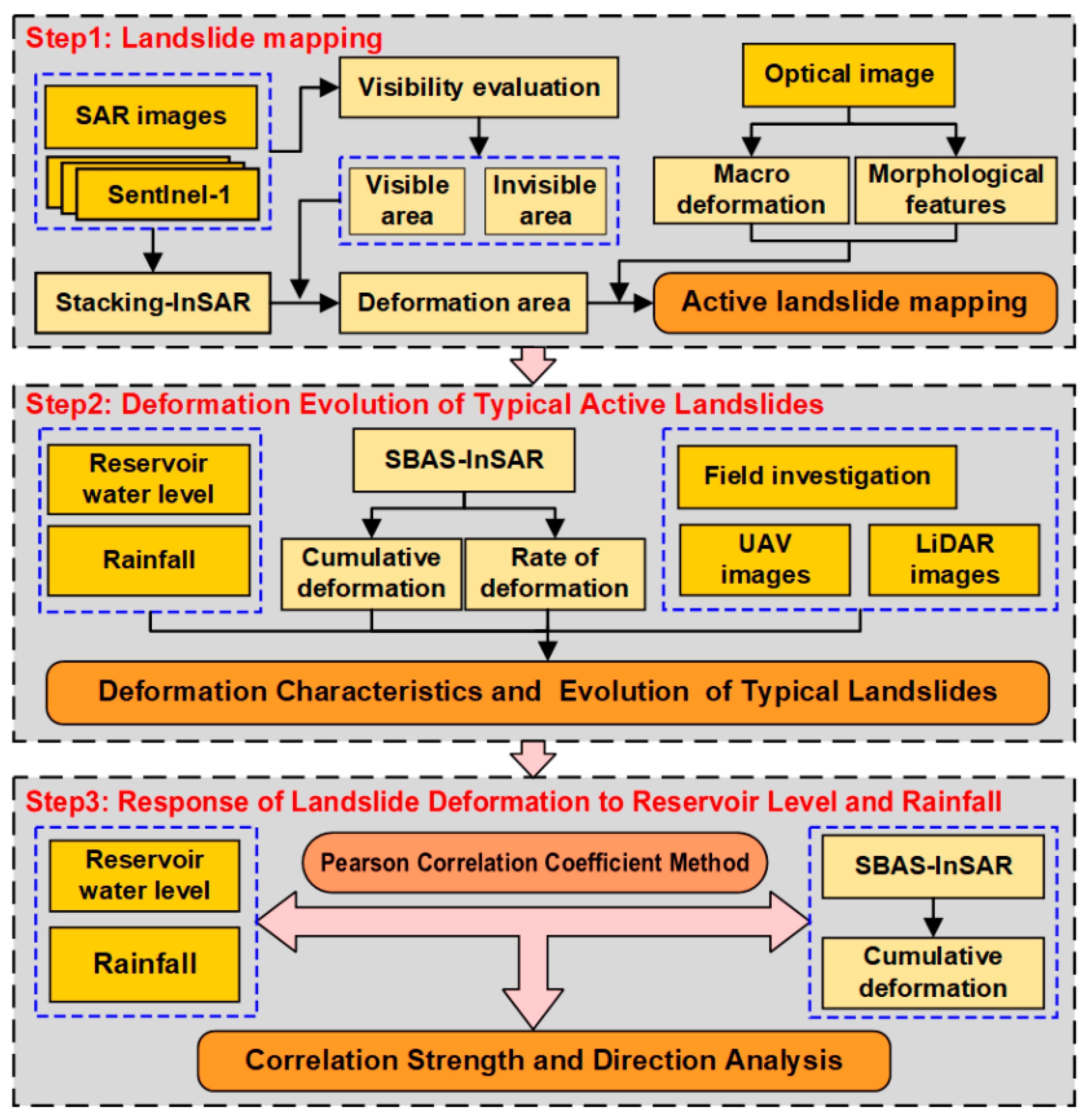
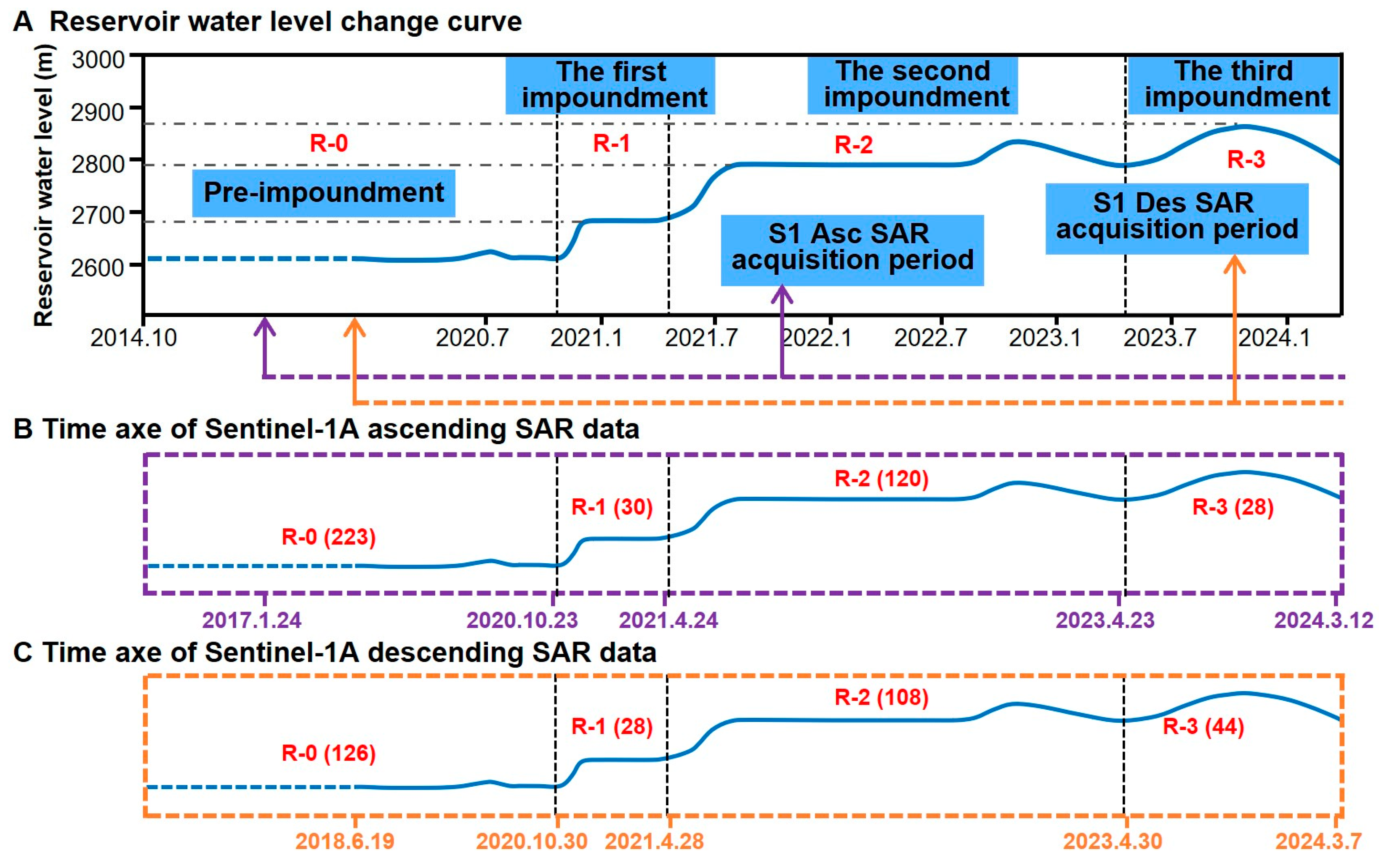
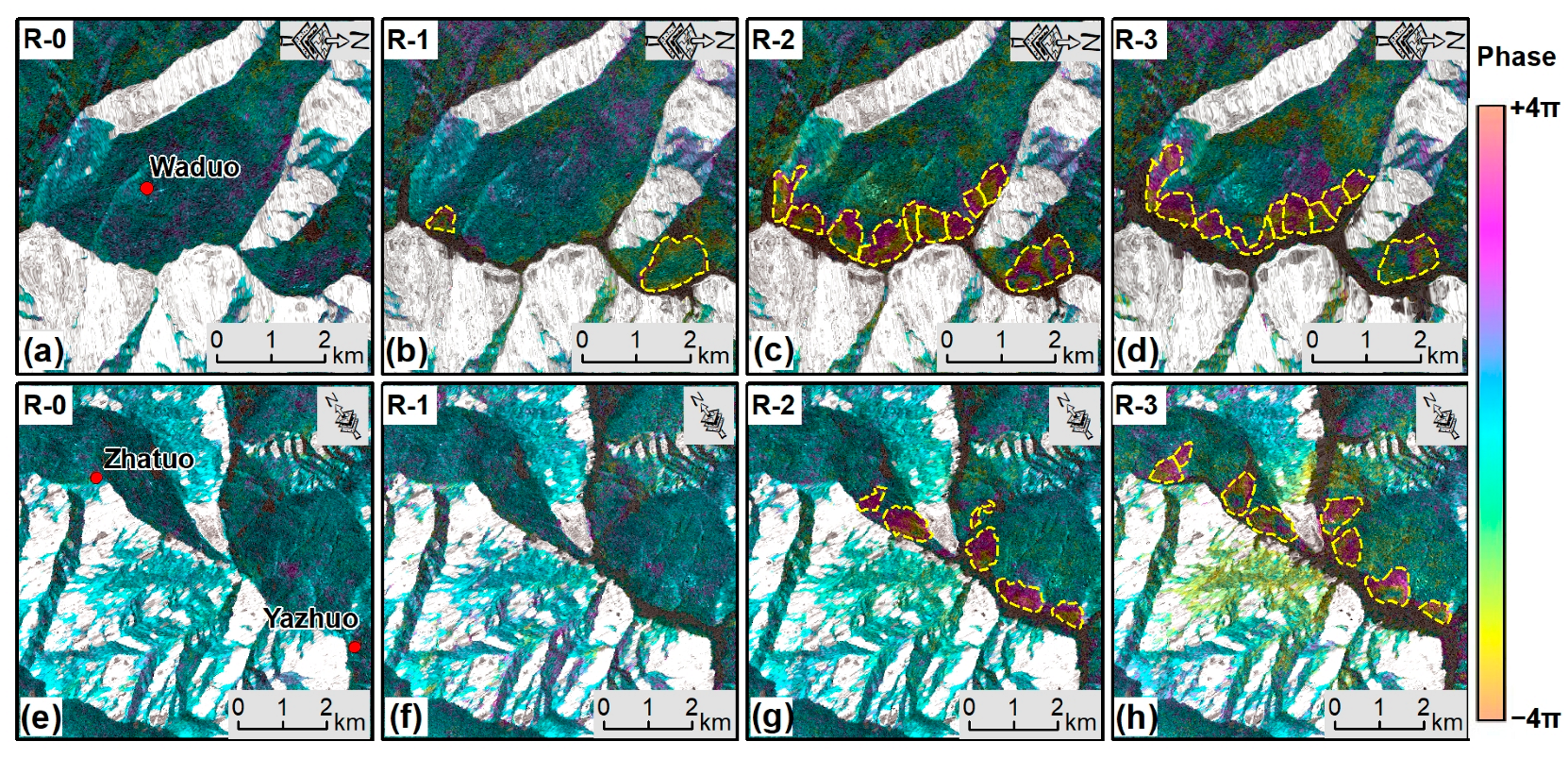
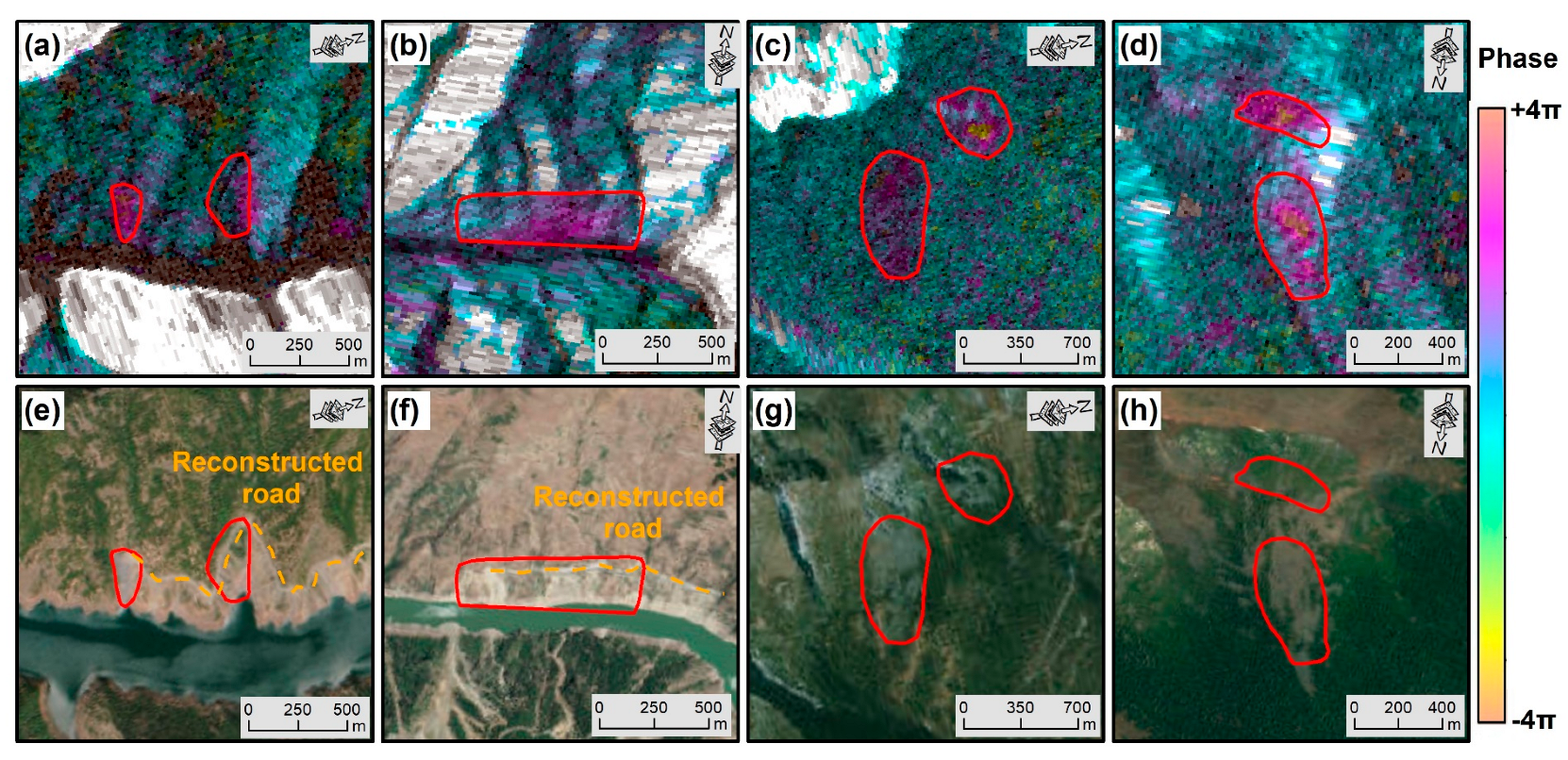
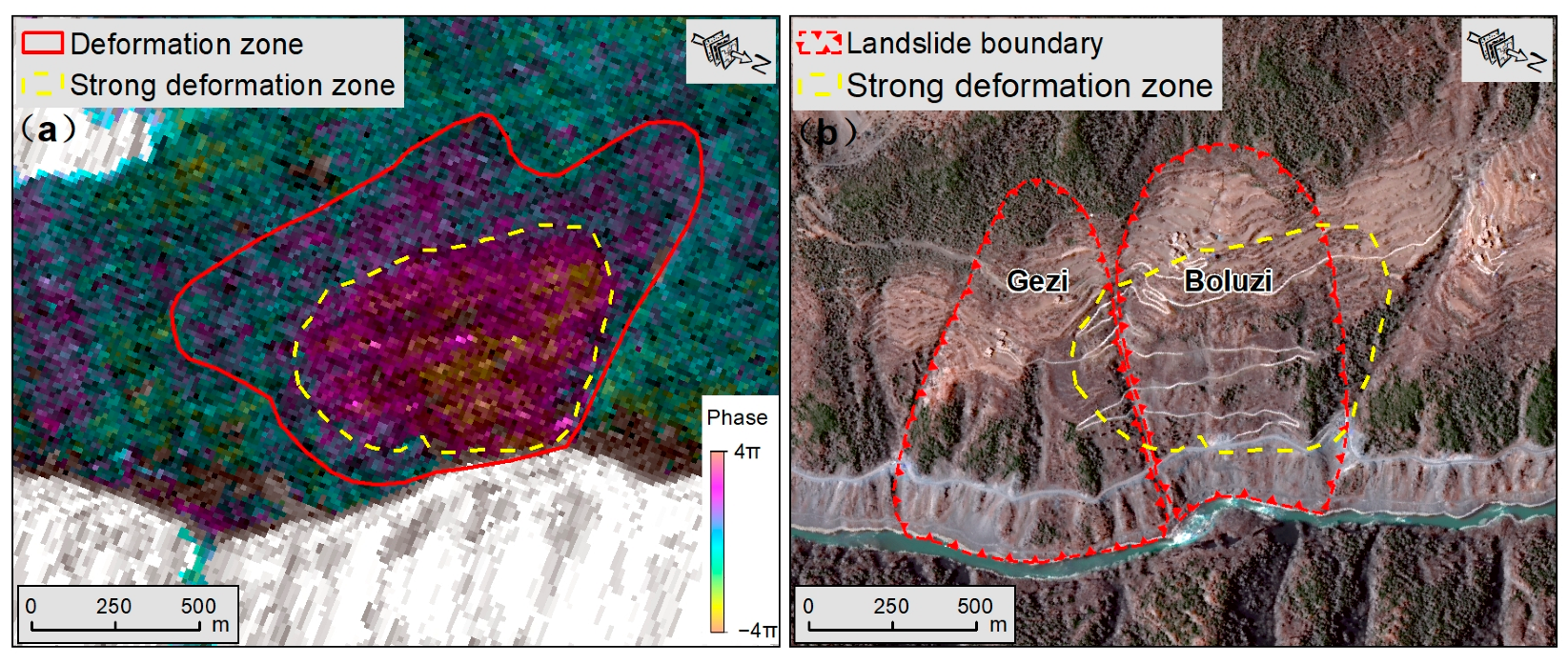
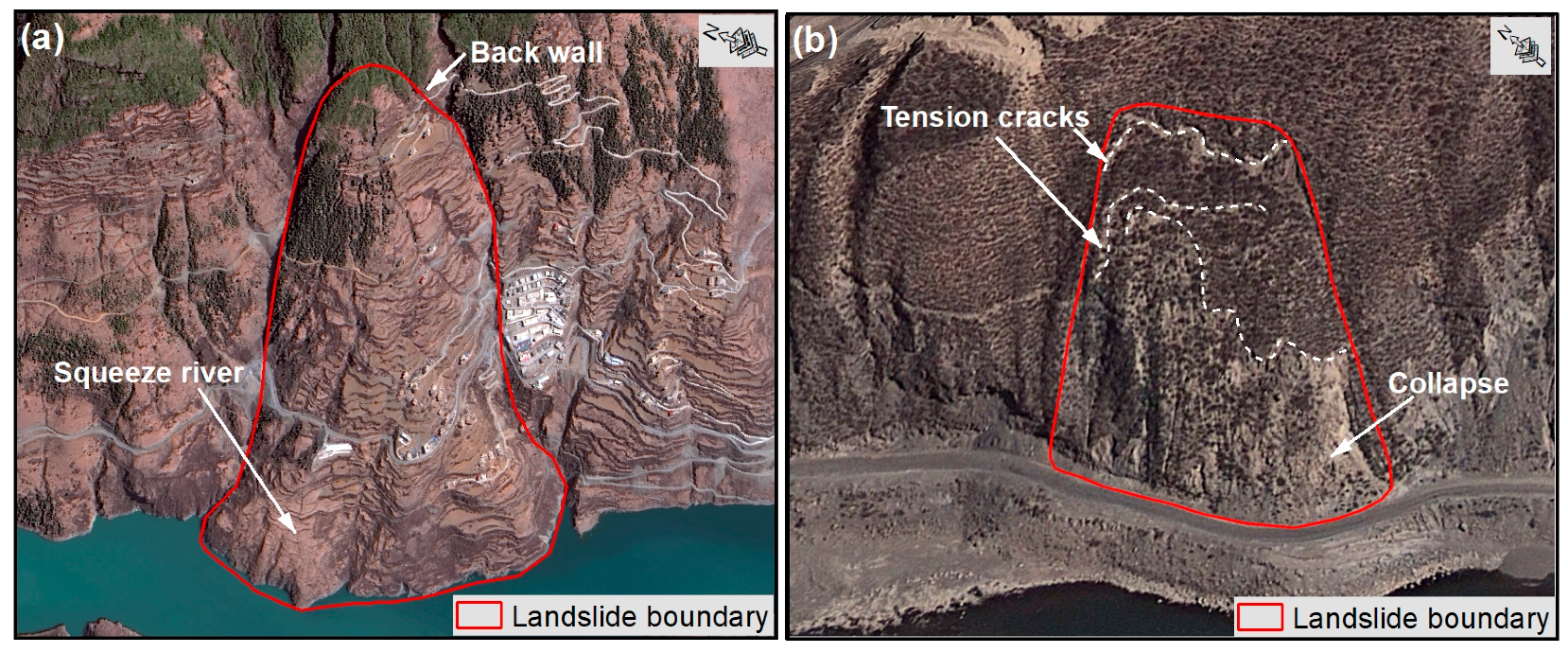
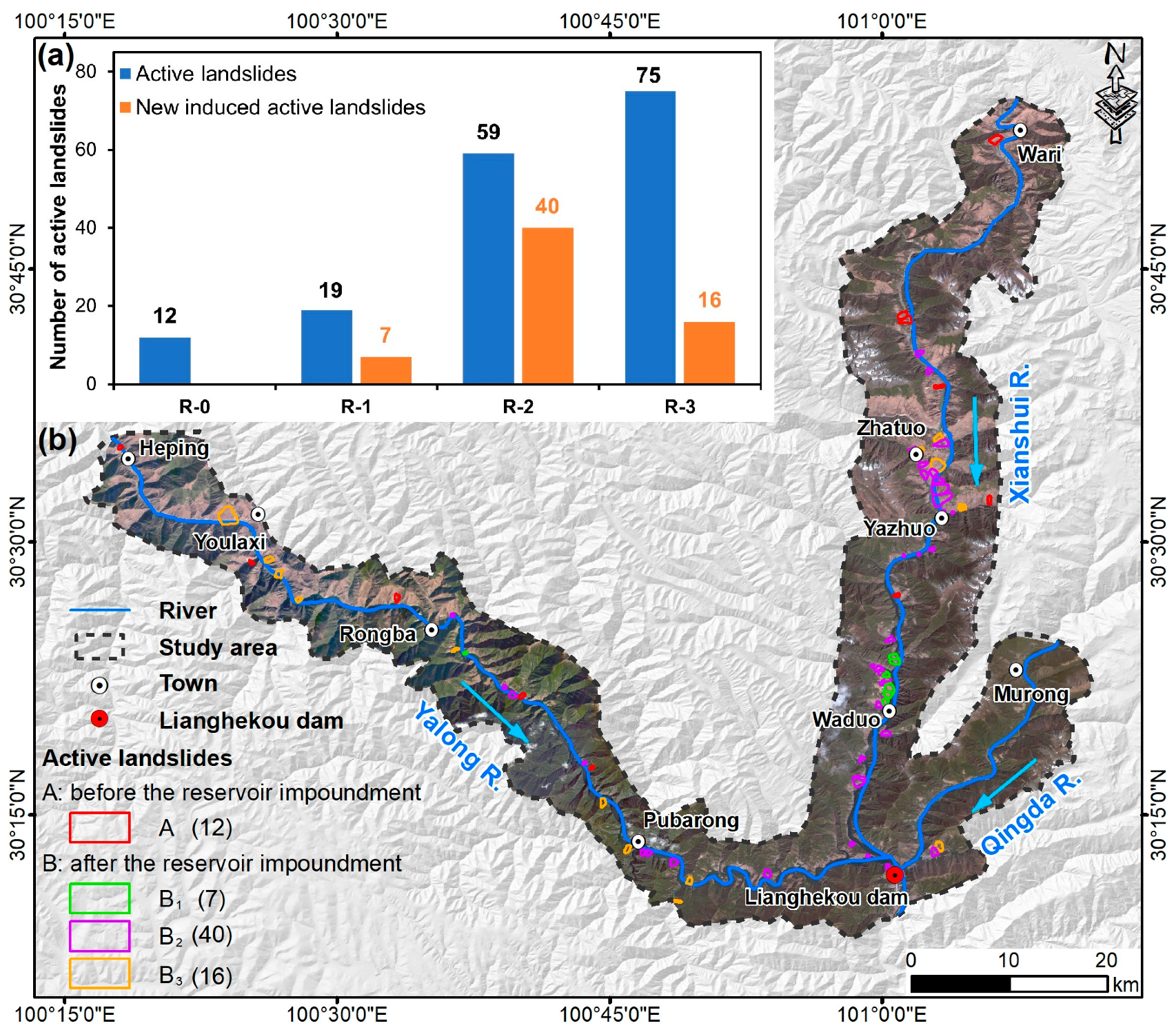
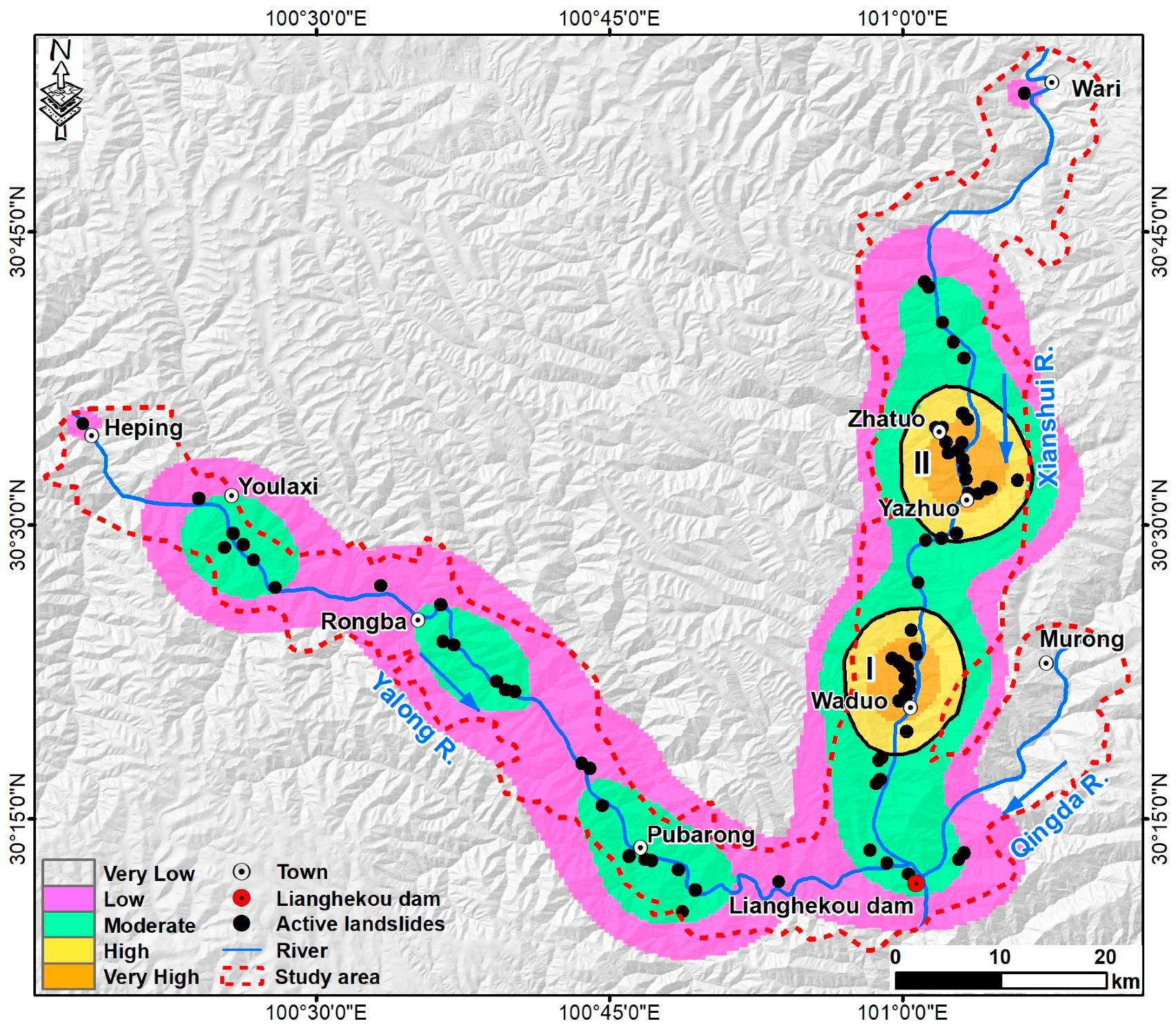
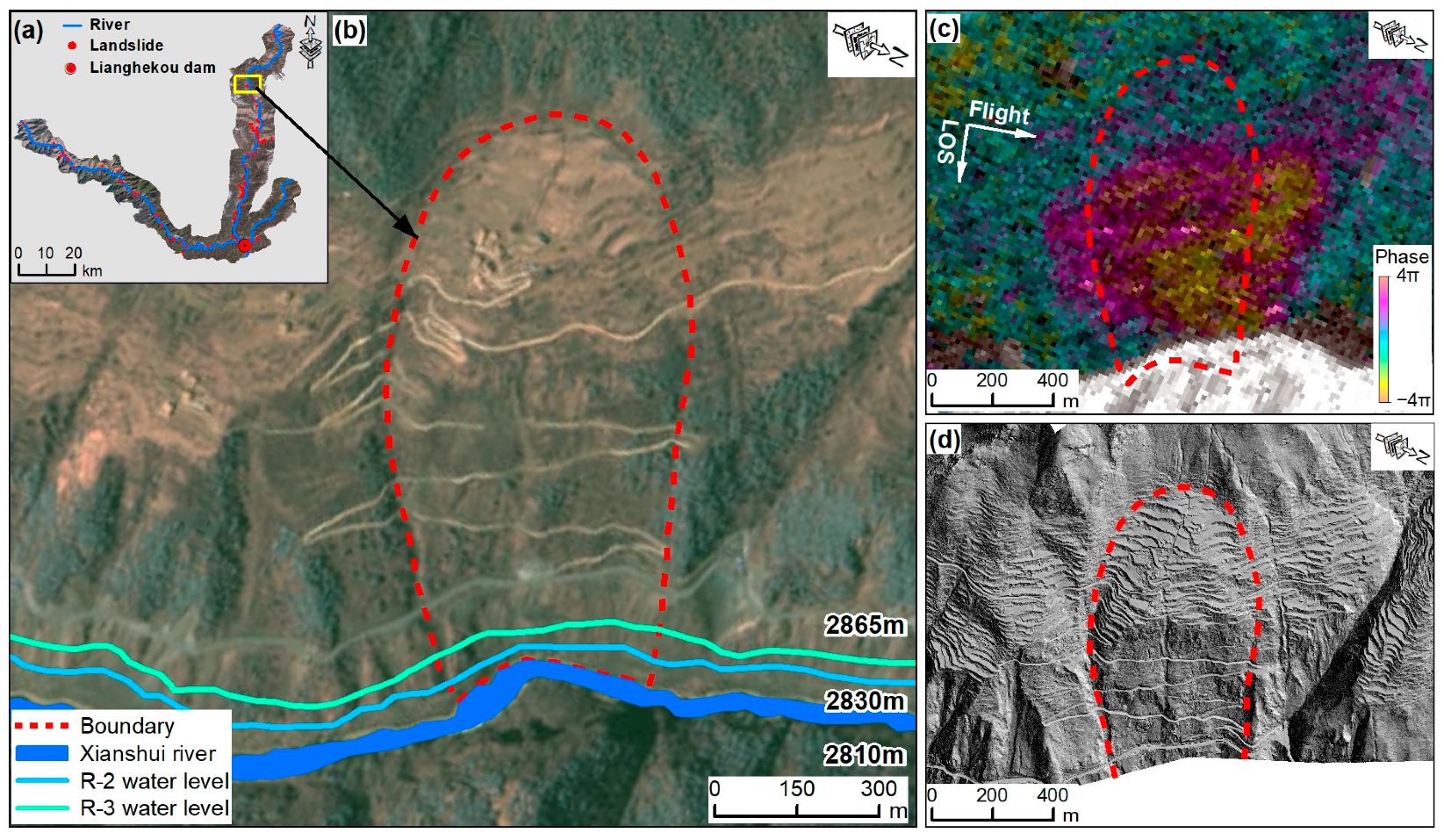

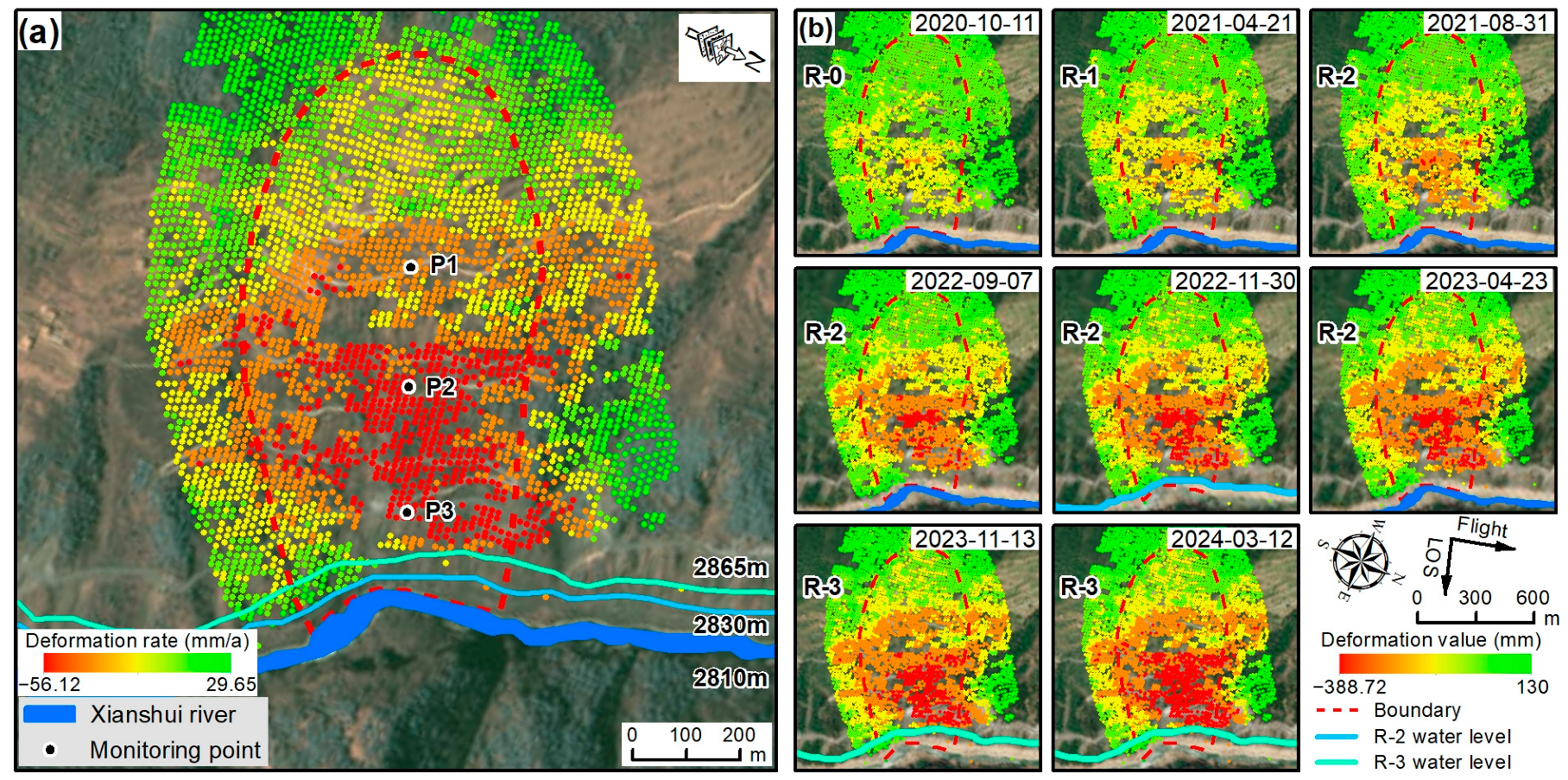

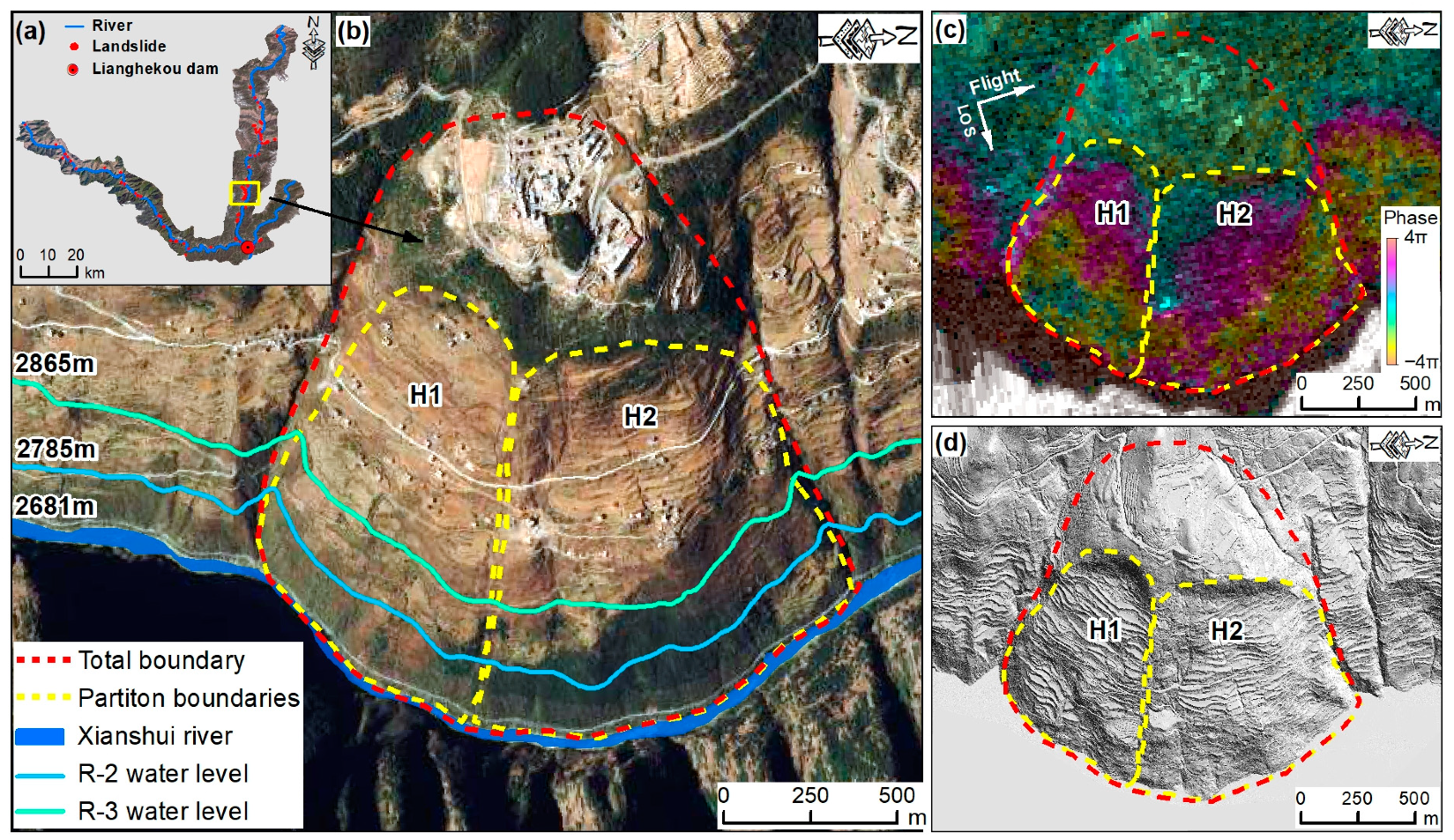
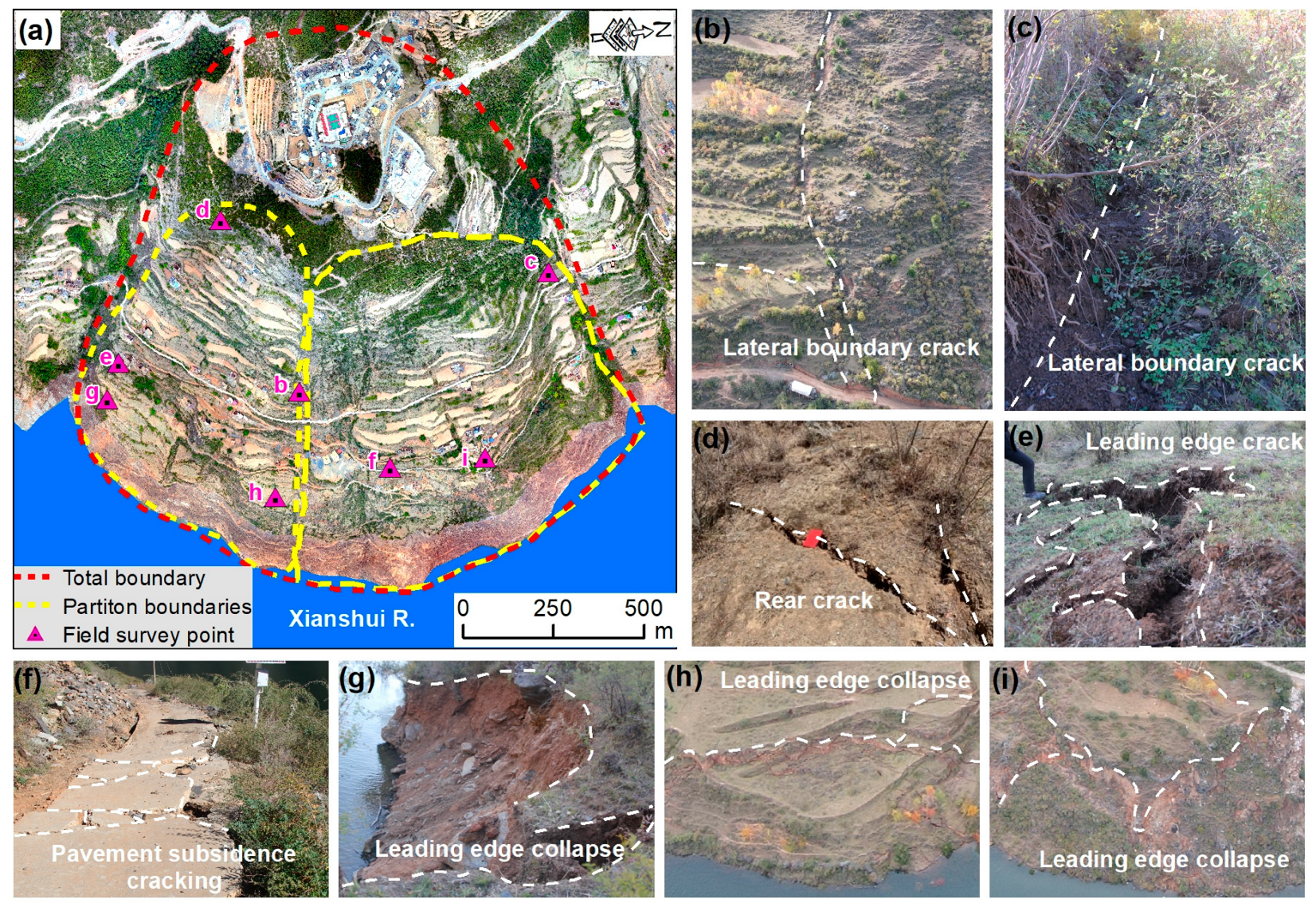
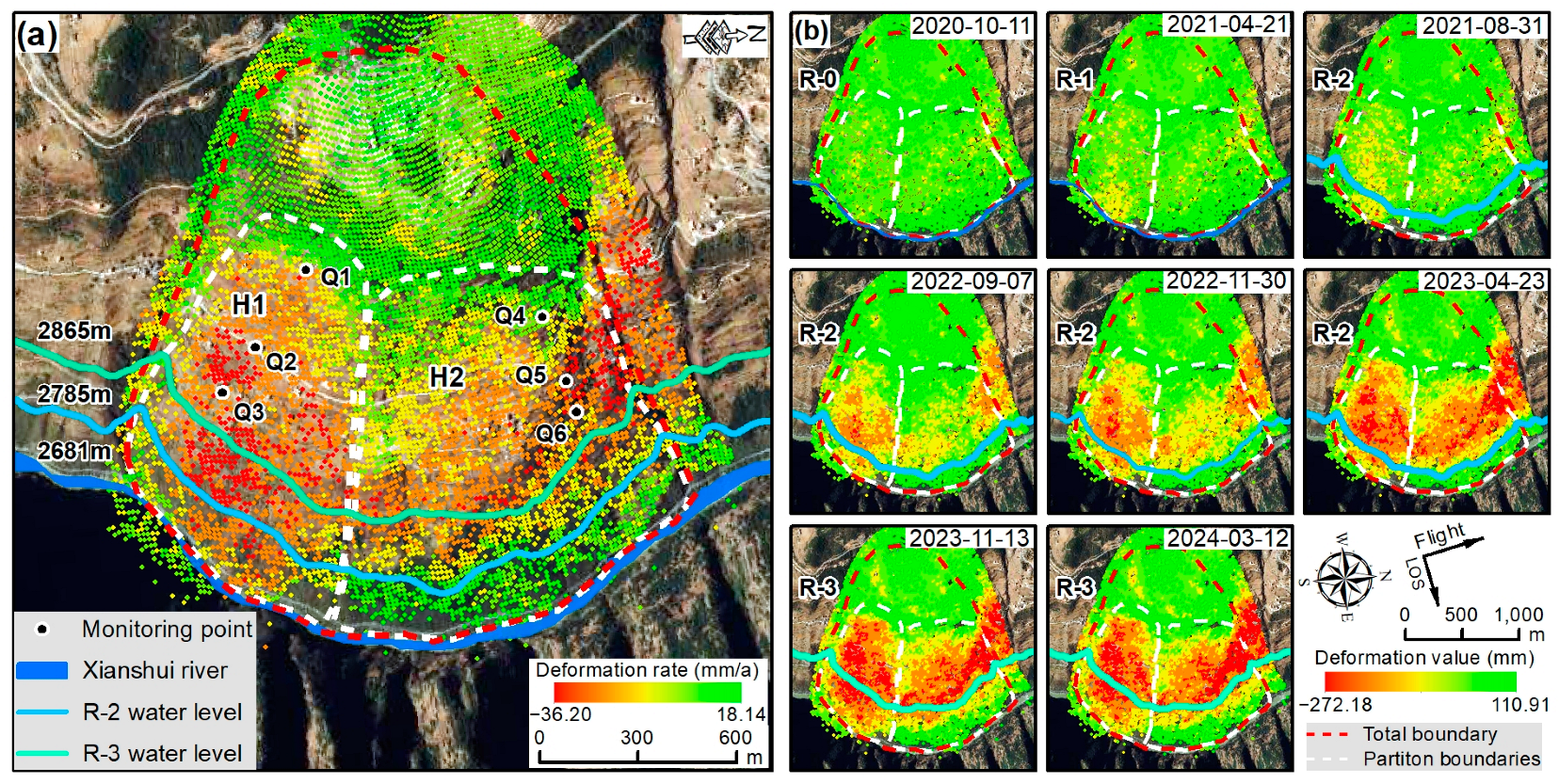
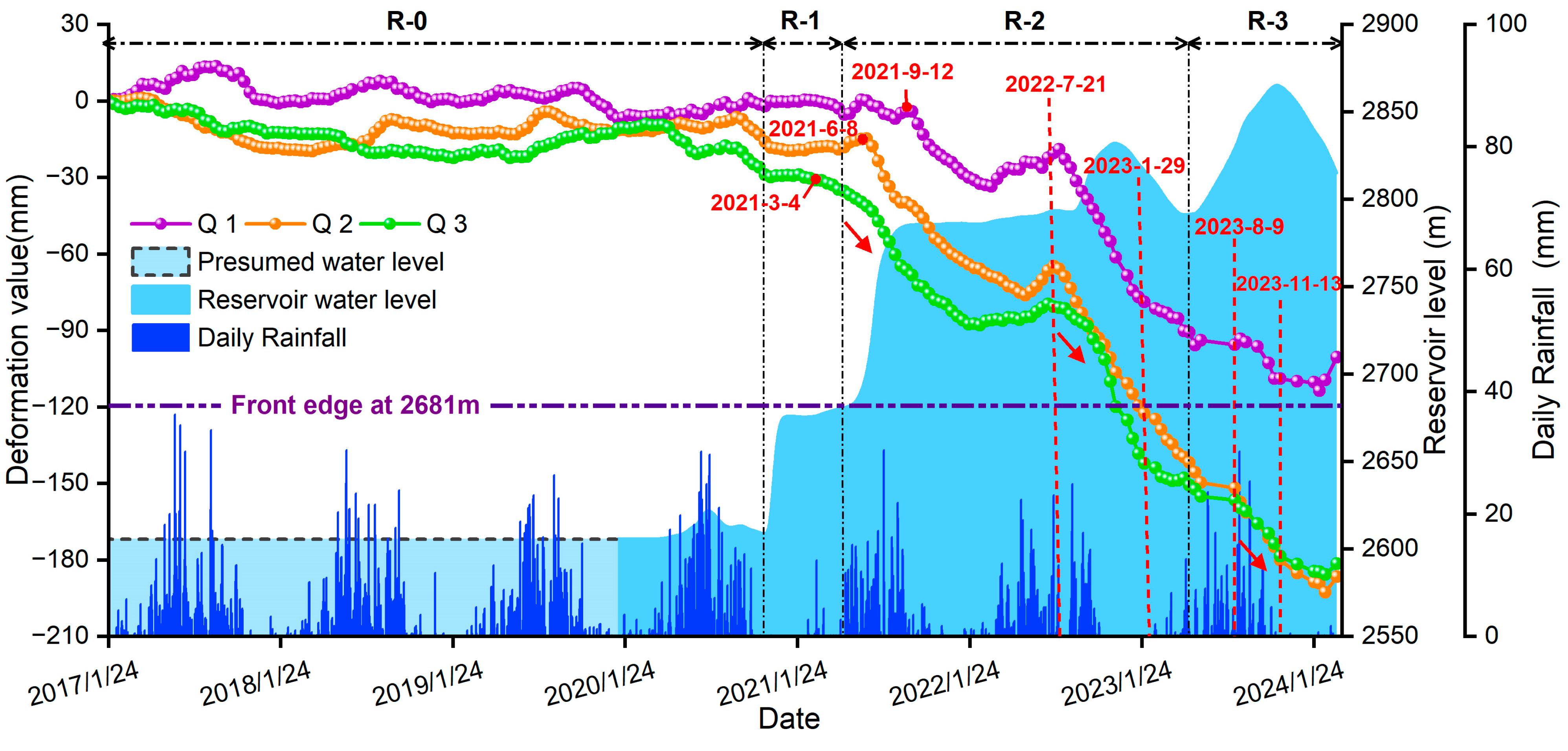
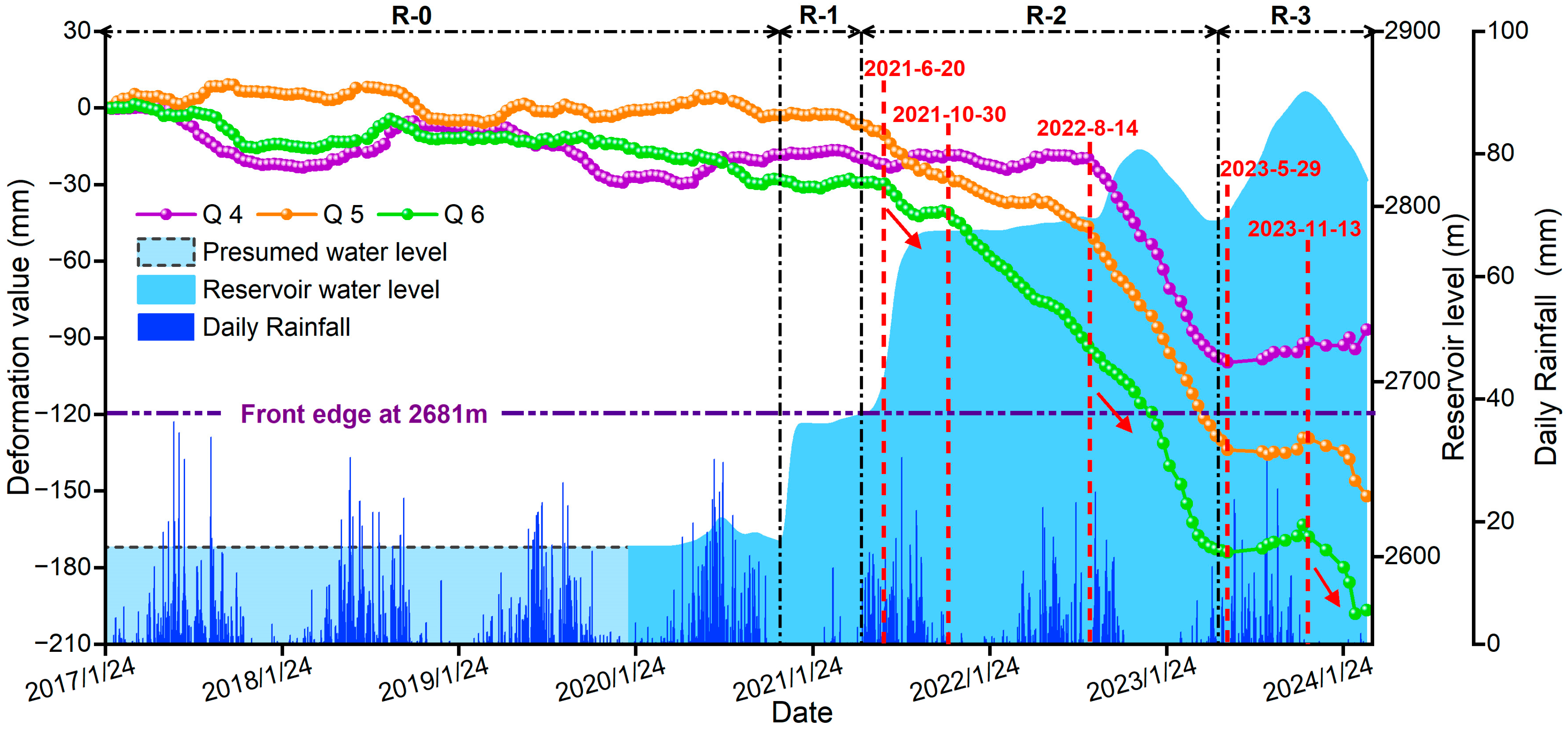
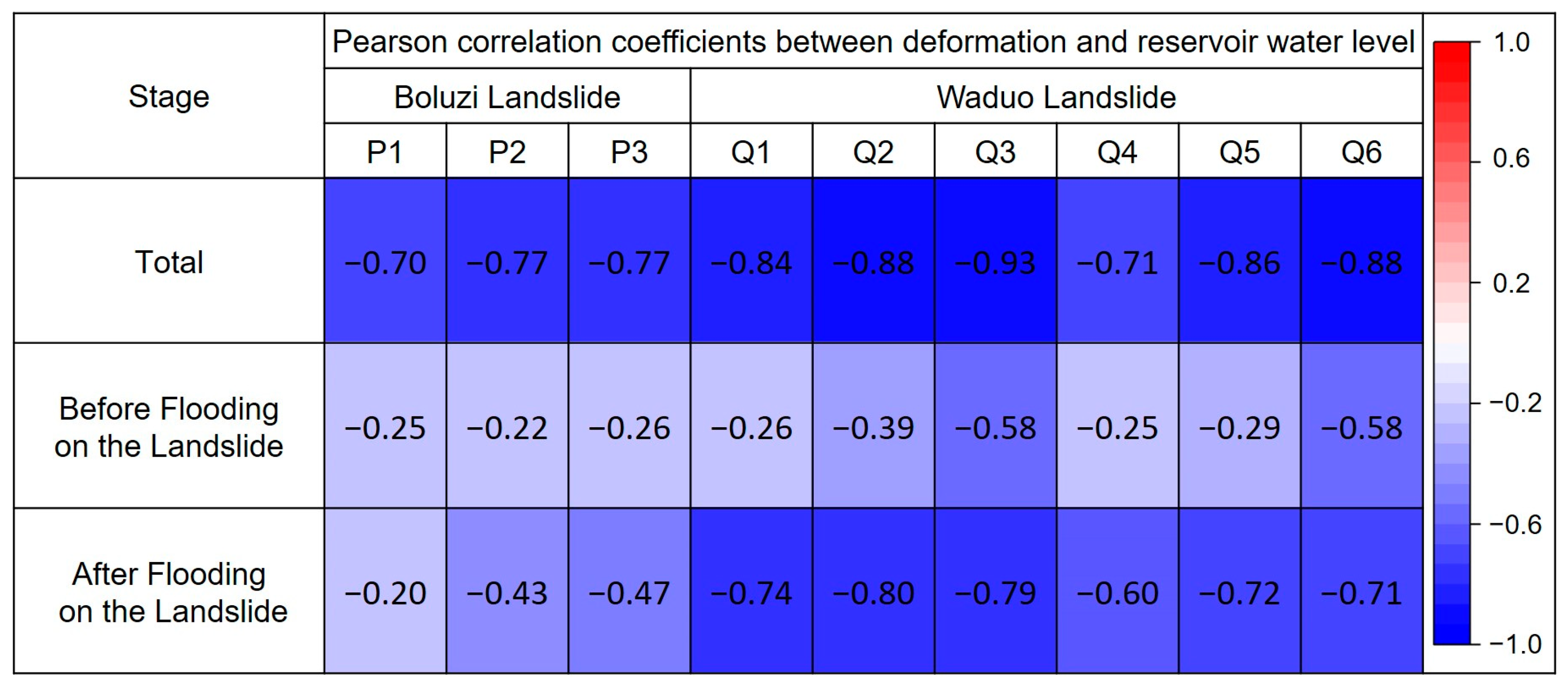

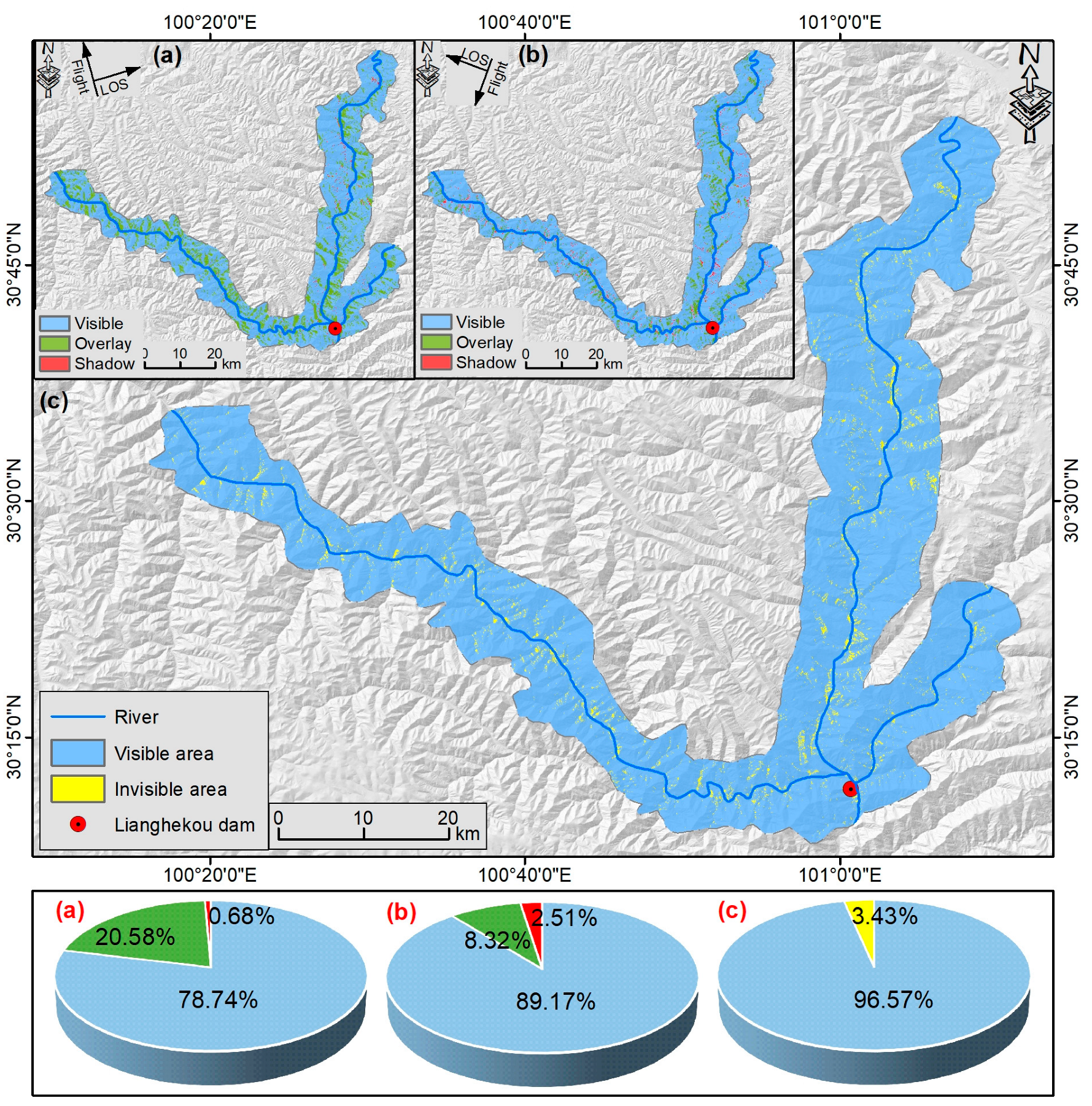
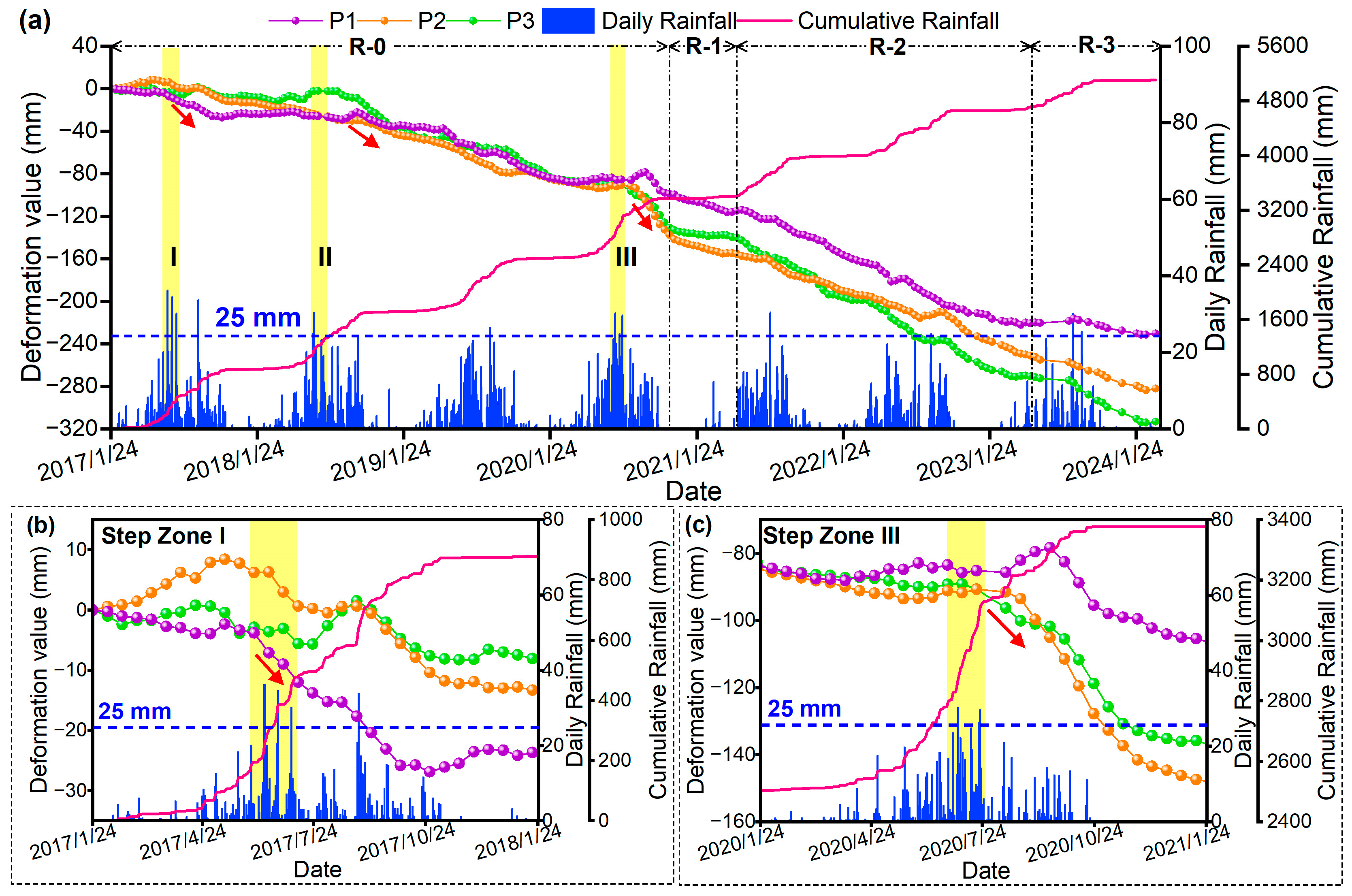

| SAR Sensor | Sentinel-1A | |
|---|---|---|
| Orbital direction | Ascending/descending | |
| Image mode | IW | |
| Polarization | VV | |
| Wavelength | C-band (5.6 cm) | |
| Resolution (azimuth/range) | 5 m × 20 m | |
| Revisit period | 12 days | |
| Azimuth angle | −12.8°/192.74° | |
| Angle of incidence | 36.94°/39.60° | |
| Collection date | 24 January 2017 to 12 March 2024 | |
| 19 June 2018 to 7 March 2024 | ||
| Scenes | 401/306 | |
| Image coverage | Ascending track: | Path 26: Frame 93/Frame 98 |
| Descending track: | Path 135: Frame 488/Frame 493 | |
| River | Total Landslides | Percentage of Landslides | Distribution | Right Bank | Left Bank |
|---|---|---|---|---|---|
| Xianshui R. | 47 | 62.7% | Mainly on the right bank | 34 | 13 |
| Yalong R. | 26 | 34.7% | Evenly distributed on the two banks | 11 | 15 |
| Qingda R. | 2 | 2.6% | Mainly distributed on the left bank | 0 | 2 |
Disclaimer/Publisher’s Note: The statements, opinions and data contained in all publications are solely those of the individual author(s) and contributor(s) and not of MDPI and/or the editor(s). MDPI and/or the editor(s) disclaim responsibility for any injury to people or property resulting from any ideas, methods, instructions or products referred to in the content. |
© 2024 by the authors. Licensee MDPI, Basel, Switzerland. This article is an open access article distributed under the terms and conditions of the Creative Commons Attribution (CC BY) license (https://creativecommons.org/licenses/by/4.0/).
Share and Cite
Li, X.; Li, W.; Wu, Z.; Xu, Q.; Zheng, D.; Dong, X.; Lu, H.; Shan, Y.; Zhou, S.; Yu, W.; et al. Identification and Deformation Characteristics of Active Landslides at Large Hydropower Stations at the Early Impoundment Stage: A Case Study of the Lianghekou Reservoir Area in Sichuan Province, Southwest China. Remote Sens. 2024, 16, 3175. https://doi.org/10.3390/rs16173175
Li X, Li W, Wu Z, Xu Q, Zheng D, Dong X, Lu H, Shan Y, Zhou S, Yu W, et al. Identification and Deformation Characteristics of Active Landslides at Large Hydropower Stations at the Early Impoundment Stage: A Case Study of the Lianghekou Reservoir Area in Sichuan Province, Southwest China. Remote Sensing. 2024; 16(17):3175. https://doi.org/10.3390/rs16173175
Chicago/Turabian StyleLi, Xueqing, Weile Li, Zhanglei Wu, Qiang Xu, Da Zheng, Xiujun Dong, Huiyan Lu, Yunfeng Shan, Shengsen Zhou, Wenlong Yu, and et al. 2024. "Identification and Deformation Characteristics of Active Landslides at Large Hydropower Stations at the Early Impoundment Stage: A Case Study of the Lianghekou Reservoir Area in Sichuan Province, Southwest China" Remote Sensing 16, no. 17: 3175. https://doi.org/10.3390/rs16173175





